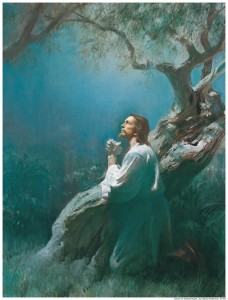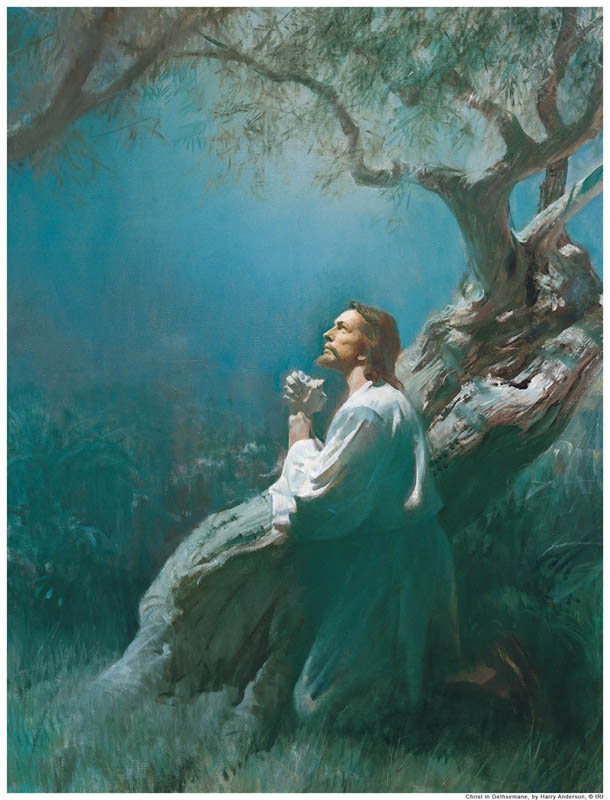When I decided to write a little about the Atonement my thoughts did not go directly to the Garden of Gethsemane. Instead they trailed back a little in time to the Passover Feast that had occurred just a few hours before. Why?
Think about the last time you had a test. Did you merely start without studying beforehand? Well, I certainly hope not. The best course to help you succeed, to claim that perfect grade, is to prepare.
 The Savior knew there was a big test, or trial, about to come upon Him. Did He know just how difficult it would be? I don’t know. I do know He realized how important it was for Him to prepare spiritually before the big test came. The Passover Feast was His way of preparing.
The Savior knew there was a big test, or trial, about to come upon Him. Did He know just how difficult it would be? I don’t know. I do know He realized how important it was for Him to prepare spiritually before the big test came. The Passover Feast was His way of preparing.
I don’t know a lot about the Passover as it is practiced today. In the Church of Jesus Christ of Latter-day Saints, nicknamed the Mormon Church, we don’t hold this feast. Our reasons for this will be discussed a little later.
For several months now Jesus had been trying to prepare His apostles for this day – the day when He would no longer reside with them on this earth in His mortal form. As these months passed rejection of Him as Savior grew steadily worse. Even members of His own family, James, Joses, Simon, and Judas (Matthew 13:55), denied Him as the Christ (John 7:2-4, 7).
“Neither did his brethren believe in him” (John 7:5).
And so He clung even more to the men who had stood by Him through His ministry, and chose to spend His last few hours in their company.
“During Jesus’ time, the Passover lambs used in the feast were killed on the fourteenth day of the month of Nissan, and the meal was eaten between sundown and midnight, in conformity with Exodus 12:6” (Skinner, Andrew C., Gethsemane, Salt Lake City: Deseret Book, 2002, p.29).
In the next several days of the Apostles lives they will come to know, as do we, the true symbolism in the Passover meal. Andrew Skinner, quoted above, gives us a basic description of this symbolism.
First is the representation of Jesus, the Firstborn of the Father, and the firstborn lamb who would be sacrificed. This lamb had to be without blemish (Exodus 12:5), as was Christ. No bone of the lamb could be broken. Through all that Christ endured, no bone of His was broken.
No stranger was to eat of the Passover lamb. Those who have not come to know of Christ and become a member of His Church should not partake of the sacrament. Just as hyssop was used to put the blood of the lamb upon the doorframe (Exodus 12:22), it was also used to bring the vinegar, at that time used as a pain reliever, up to Christ as He hung on the cross (John 19:29). Lastly, the blood of the Passover lamb had been a symbol to the destroying angel of their belief in Christ. So now would the blood of the Lamb of God allow us, His believers, to be free from sin and spiritual death.
The day of the Passover Christ sent Peter and John to one of His believers, or a disciple, asking to use the upper room. The lamb was slaughtered at the temple, and roasted according to law. At the appropriate time he sat down with His Apostles, His friends, and said, “With desire I have desired to eat this Passover with you before I suffer” (Luke 22:15). It was at this time He began to teach them about the true meaning behind the Passover Feast, a feast He instituted over 1200 years before.
The order of events went according to custom until the traditional breaking of the unleavened bread. Instead of reciting the customary blessing Jesus “took bread, and gave thanks, and brake it, and gave unto them, saying, This is my body which is given for you: this do in remembrance of me” (Luke 22:19).
I would imagine this breaking of tradition astounded the Apostles. Did they realize at that moment the new law Christ was instituting?
Yet another change occurred. “Likewise also the cup after supper, saying, This cup in the new testament in my blood, which is shed for you” (Luke 22:20).
Christ had shown His Apostles a new ordinance, that of the sacrament. This was to replace the sacrifice of the lamb, for He was the Lamb. It brought home the importance of individual commitment and interaction with God. Our sacrifice now should be a humble heart and a contrite spirit, represented through the bread (body of Christ) and wine (blood of Christ). This is why members of the Latter-day Saint Church no long practice the Passover Feast, but rather partake of the sacrament (though we use water instead of wine).
All of this was of vital importance in preparing the Lord for what was to come. Introducing the sacrament fortified Him spiritually and emotionally to face His future. The night was far from over. Christ offered up what is now known as the Intercessory Prayer (John 17). In one of His last lessons, Christ washed the feet of his friends. Then it was time to go.
As Christ and the Apostles left it was very late at night. Even without what was to come I’m certain they were all fairly exhausted. I love that one of His last acts before going into the mount of Olives was to sing a hymn (Mark 14:26), for music is one of the most powerful tools to keep the Holy Spirit close by.
At this point all had been done by the Savior to prepare Himself for the agony of Gethsemane.
The lesson we can gain from this is simple: we must spiritually prepare ourselves for whatever may come. None of us will ever be asked to endure what the Savior did, but we will have our own trials to bear. If we do not prepare ourselves now, it will be like heading into that classroom knowing there is a test and having not studied a word.


